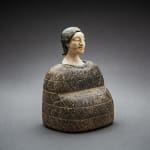Bactrian Composite Stone Idol, 2000 BCE - 1800 BCE
Stone
12.1 x 8.6 cm
4 3/4 x 3 3/8 in
4 3/4 x 3 3/8 in
LO.1293
Further images
In 2003 one inventory calculated that there were at least thirty-eight examples of such Bactrian idols known. Although the number of examples inventoried since that time has increased, the total...
In 2003 one inventory calculated that there were at least thirty-eight examples of such Bactrian idols known. Although the number of examples inventoried since that time has increased, the total number of such Bactrian idols remains relatively small. Nine examples have been founded in southeastern Turkmenistan and two more in Pakistan. The discovery of a silver pin depicting a kaunakes-clad woman sitting on a small backed chair and of silver vessel depicting a second, similarly dressed female figure, kneeling on the ground, at the site of Gonur-depe in Turkmenistan suggests that the origin of such figures is to be sought in that area.
The eleven examples just cited, although discovered in archaeological contexts, were not accompanied with related finds sufficient to define the nature of the kneeling women depicted in the kaunakes. Although some scholars prefer to identify them as elite members of this early society, other scholars, noting their compelling monumentality, suggest these female figures are depictions of one or more goddesses. Indeed, their faces are imbued with the look of divine authority. The use of different colored stones in their design would seem to support such a divine interpretation for such spiritually-charged beings where the focus of one’s attention comes to rest on their head and face.
Recent Carbon 14 dating of some of the organic material found in association with some of the excavated examples suggests a chronological position for the group in the early second millennium BC about 2000-1800 BC. The use of different colored stone is apparently consistent with this dating. The technique appears to be used for the creation of composite figures of approximately the same dimensions excavated at Ebla. In its simplicity and in its inherent monumentality, the figure resonates with contemporary aesthetic taste. As such, this idol reveals the timelessness of the mother goddess and her continuing ability to command both attention and respect.
The eleven examples just cited, although discovered in archaeological contexts, were not accompanied with related finds sufficient to define the nature of the kneeling women depicted in the kaunakes. Although some scholars prefer to identify them as elite members of this early society, other scholars, noting their compelling monumentality, suggest these female figures are depictions of one or more goddesses. Indeed, their faces are imbued with the look of divine authority. The use of different colored stones in their design would seem to support such a divine interpretation for such spiritually-charged beings where the focus of one’s attention comes to rest on their head and face.
Recent Carbon 14 dating of some of the organic material found in association with some of the excavated examples suggests a chronological position for the group in the early second millennium BC about 2000-1800 BC. The use of different colored stone is apparently consistent with this dating. The technique appears to be used for the creation of composite figures of approximately the same dimensions excavated at Ebla. In its simplicity and in its inherent monumentality, the figure resonates with contemporary aesthetic taste. As such, this idol reveals the timelessness of the mother goddess and her continuing ability to command both attention and respect.





